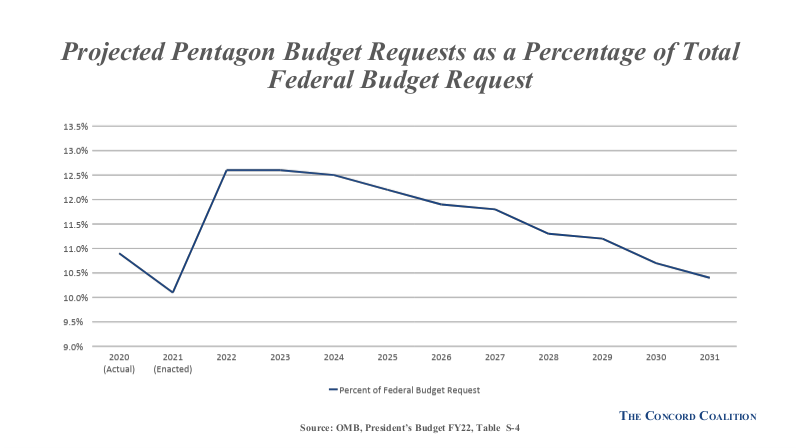by Tim Tyndall
Introduction
In part one of this defense primer, readers learned that the defense budget is a significant portion of the federal budget (about 15% in 2019), approximately 96% of which is Department of Defense spending (the Pentagon’s budget). This installment examines President Biden’s defense proposal for the upcoming fiscal year, FY 2022, and beyond.
Each year, the Department of Defense submits a budget request to Congress detailing its needs (personnel, housing, weapons, ships, planes, ordnance, materials, etc.) and the funding required to meet them. DoD bases its request on the President’s vision for national defense and his or her strategy for deploying military resources to achieve the stated goals. A President’s defense budget reflects the administration’s perception of threats around the globe and the resources required to neutralize them.
The FY 2022 request is the first defense proposal under the Biden Administration, and it sheds some light on the administration’s security priorities. Insights will be limited, however, by the lack of a Future Years Defense Program (FYDP), which details the sitting administration’s plans for defense spending eight years into the future. The FYDP typically is not released in the first year of a new administration due to the brief interval between the transfer of power and the first budget request. Nonetheless, there are some notable changes to the FY22 Pentagon budget worth discussing here.
Spending Levels
President Biden’s overall defense request for FY22 totals $756 billion.1 Of this, $715 billion would be appropriated for the Department of Defense.2 This sum is $11.3 billion more than enacted in 2021, an increase of 1.6%.
This increase does not compensate for the cost of inflation,3 nor do any of the annual increases in defense spending for the projected period of 2022-2031 sufficiently compensate for inflation. In fact, the Biden Administration’s projections would amount to a cumulative real decrease in spending of $312 billion over the ten year period.
In the final year of the projections (FY 2031) , defense spending would be $73 billion less than it would if it were to keep pace with inflation over the projection period – a 7.9% disparity. To understand the impact of a 7.9% decrease in defense spending, consider that 7.9% of the FY 2022 request covers the entirety of pay and benefits for all military personnel in the Navy and Marine Corps, including reserves.4

Defense is also set to shrink as a proportion of the overall federal budget. In 2019, total defense spending comprised 15% of the federal budget. Emergency spending on COVID relief in FY 2020 and FY 2021 artificially suppressed that ratio, (as seen in the graph below), but even once the budgetary effects of COVID wane, President Biden’s budget proposal would result in a defense budget that is an even smaller portion of total federal spending.

Composition of the Pentagon Budget
There are some notable changes in the way President Biden intends to spend defense dollars. His defense priorities reflect a desire to confront the rise of China by deploying greater resources towards research and development, and to confront the military’s contribution to climate change. Both leave an indelible mark on the FY 2022 Pentagon budget.
Spending by Military Department. One of the simplest ways to perceive this shift is in the relative funding of the military departments, which can be seen in the table below. As the military continues to turn its focus towards the Pacific, the Pentagon is looking to shift funding away from the Army and Defense-Wide spending towards the Departments of the Navy and Air Force (which include the Marine Corps and Space Force, respectively). The Biden budget cuts Army funding by almost 1%, or $1.5 billion from its 2021 enacted funding total, and the Defense-Wide budget would be $600 million (about 0.5%) smaller. Meanwhile, the Department of the Navy will see a $4.6 billion, or 2.2% increase to their budget, while the Department of the Air Force will see an $8.8 billion, or 4.3% increase.

Spending by Major Weapons Category. Another way of examining how the shifting nature of our security threats is shaping the Pentagon budget is to look at how spending will be apportioned between categories of major weapons systems.5 Notably, proposed spending on major weapons systems overall is set to decrease by $5.3 billion, or 6.2% – from $85.1 billion enacted in 2021 to $79.8 billion requested in 2022.6
Spending on aircraft is reduced by 18.3% in the Pentagon budget request, from $30.7 billion enacted in 2021 to $25.1 billion requested in 2022. Ships will also take a significant hit, decreasing from $16.9 billion to $15.4 billion, or 9.7%.
On the other hand, missiles and nuclear defense systems will see an increase of 5.2%, from $31.6 billion in 2021 to $33.2 billion in 2022. Space systems will also increase from $5.9 billion to $6.1 billion, or 3.4%.

Spending by Public Law Title Categories. As noted in part one of this primer, the Pentagon budget is separated into seven public law titles. The relative proportions of these categories in the 2022 Pentagon budget request can be seen in the table below.

The most noteworthy change in the proportional funding by public law titles between 2021 and 2022 is the shifting of emphasis in acquisitions spending to the tune of an $8 billion decrease in Procurement spending and a $5.5 billion increase in RDT&E (research and development). That constitutes a 5.7% decrease in Procurement (from $141.7 billion to $133.6 billion) and a 5.2% increase in RDT&E (from $106.5 billion to $112 billion).
Cutting Defense is Not a Cure-all
Americans have consistently and severely overestimated the portion of the federal budget dedicated to defense, and that number continues to shrink – from 15% of the budget in 2019 to 10% in 2031 according to current projections. Our nation’s fiscal woes simply cannot be solved by reducing defense spending alone – there just isn’t enough money there.
Comparing defense spending to interest payments on the debt perfectly illustrates this. In Biden’s 2022 budget, net interest payments are equal to 1.3% of GDP, whereas defense spending is significantly higher at 3.2% of GDP. Projected spending over the next ten years, however, paints a very different picture, with defense steadily decreasing, and interest payments steadily increasing as a percent of GDP. In fact, by 2031, interest payments as a percentage of GDP are projected to reach 2.7%, overtaking defense spending at 2.5%,7 as seen in the chart below. Consider as well that In President Biden’s budget the deficit in 2031 (4.7% of GDP) is nearly twice the size of projected defense spending in that year. Even eliminating all defense spending, which is obviously not a rational policy option, would still leave a substantial gap.

It should also be noted that defense spending is a key national priority and reducing it by too much could put the nation and its allies at risk. So, while the Concord Coalition applauds the Biden Administration’s goal of decreasing the rate of growth in defense spending, the entire budget must be subject to scrutiny in the effort to put U.S. fiscal policy on a sustainable path while maintaining our national security.
Footnotes
1 Office of Management and Budget, President’s Budget, Table S-4
2 Office of Management and Budget, President’s Budget, Table S-8
3 Using GDP chained price index, percent change, year/year. Source: Office of Management and Budget, President’s Budget, Table S-9
4 Department of Defense, Fiscal Year 2022 Budget Request, Table A-3
5 Totals include spending for Procurement and RDT&E combined
6 Department of Defense, Fiscal Year 2022 Budget Request, Figure 2.2 on page 2-7
7 Office of Management and Budget, President’s Budget, Table S-5
Continue Reading







